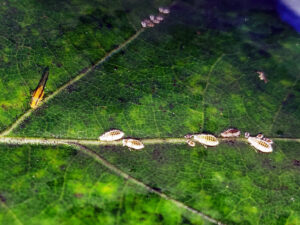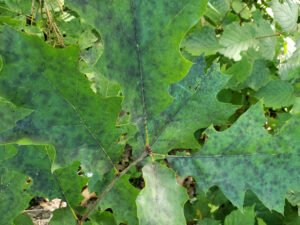
Myzocallis aphids feed on the top side of oak leaves. An adult is pictured on the left. / Photo Credit: Linda Williams, Wisconsin DNR
By Linda Williams, DNR Forest Health Specialist, Woodruff; Linda.Williams@wisconsin.gov or 920-360-0665
and Bill McNee, DNR Forest Health Specialist, Oshkosh; bill.mcnee@wisconsin.gov or 920-360-0942
Aphids — and the honeydew they produce — have made their mark on trees in Wisconsin during 2023.
Midway through the summer, oak trees in areas of Vilas and Oneida counties were buzzing with activity. During September, beech trees in eastern Wisconsin became busy with a different species of aphid.
A look at the two situations:
Aphids On Oak Leaves
Bald-faced hornets and yellowjackets were seen buzzing around leaves; the numbers were high enough that you could hear the buzzing if you stood under these trees and even felt tiny drops of liquid dripping down onto you. A closer look revealed that the trees appeared to have two types of aphids present on their leaves, although both seemed to be Myzocallis species.

Sooty mold growing on leaves of understory oaks after honeydew from aphids dripped down onto them. / Photo Credit: Linda Williams, Wisconsin DNR
Aphids can be found nearly every summer at low levels, but this year the numbers were slightly higher than normal. A common species of aphid was found on the undersides of the leaves, but this year there were some less-common aphids also found on the oak leaves and in abundance. The less common species of aphid were larger than other observed oak aphids and had a greyish color with white markings. They fed primarily on the upper surfaces of the leaves and could typically be found lined up along a leaf vein, tapped directly into the sap flowing through those veins.
So why were the trees also buzzing with bald-faced hornets and yellowjackets? Aphids are a great protein source for those insects (and others), and they’re easy to carry back to the nest. Additionally, aphids excrete honeydew, which drips down onto anything below them. This sticky, slightly sweet liquid also attracts insects. When honeydew lands on things below the tree, sooty mold can grow on it, turning things black.
Aphids tend to do better during hot, dry summers, such as the one Wisconsin experienced this year. Fortunately for the trees, the wasps were more than happy to take advantage of this plentiful food source and kept the aphids under control.
If next year is wetter or cooler, the aphids won’t do nearly as well. Additionally, predators, parasites and fungal pathogens are plentiful and will help keep them under control.
Beech Blight Aphids Abundant

A colony of beech blight aphids spreads over a twig in Door County. / Photo Credit: Wisconsin DNR
Beech blight aphids (Grylloprociphilus imbricator) became very visible on beech trees in the eastern part Wisconsin in September.
Their bodies are coated with long, white filaments, giving them a woolly appearance. It is known as the “boogie-woogie aphid” because the entire colony will start shaking when disturbed. It’s a way to try scare off a potential predator.
They seldom pose a threat to their host tree, although dieback of heavily infested branches can sometimes occur. The colonies can be an eyesore and are known to produce abundant, sticky honeydew that results in sooty mold on driveways, sidewalks and outdoor furniture. Ants are often attracted to the honeydew droplets.
Control is usually not necessary to protect tree health. If needed or desired, a strong stream of water will dislodge the colony. Insecticides, horticultural oils, and insecticidal soaps are alternative management options.
